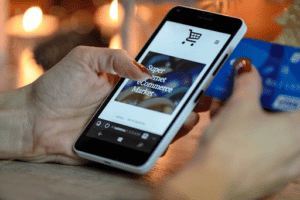

Digital transformation is changing the way businesses collect data. Yet, many still find that they have unorganized and scattered data. This is because they lack the appropriate technology necessary to leverage this transformation and drive business outcomes.
So, how can your organization develop a strategic data collection plan to optimize the customer experience and stay on top of market trends?
Adapting to digital transformation requires extensive planning for budget, regulations, and resources. Before initiating the transition to new digital technology, it’s essential to accommodate change management controls. As Chirag Deshpande, Client Services Director at Search Discovery, says, “It involves a lot of team members, involves a lot of people, processes, changes, adoption, education. So you definitely have to account for all of those elements as part of your implementation. So it’s not just, hey, here’s the platform.” You have to allow for getting acclimated to the platform.
Change management involves bringing in multiple team members within IT and web development to learn how to use the platform and administer technology governance. By undergoing a rigorous education process, you can minimize software glitches, alterations, and technical errors.

Another significant aspect to keep in mind when exploring new software is determining how your data is connected and where it originates. Countless organizations find their data spread across millions of individual profiles, consequently losing track of customers.
What can you do to separate your data?

To start, you can merge your company’s databases with your customer relationship management data (CRM). To accomplish this, try applying a data mapping strategy to determine the information you have on hand and what information you need to make an effective transition. With data mapping, you can identify patterns in your data that can help you solve business problems and prepare for future data sources.
By organizing your data in this fashion, Chris Sessoms, Manager of Web Technology and Infrastructure at Red Hat, maintains that you can “Do some progressive [data] profiling and fill in some holes in [your] first-party data.” Profiling will enable you to establish the most relevant data to incorporate into the software.
Adobe Experience Platform (AEP) is a customer data platform (CDP) that allows companies to consolidate their data into a single profile.
This platform creates a seamless customer experience across multiple channels to promote business growth. Patty Behre, Optimization Tech Manager at Red Hat, mentions that her organization implemented AEP to limit data inefficiency and garner insights from customer data for individual use cases.
As a result, Red Hat achieved “a 3,000% ROI” “by using first-party audiences,” according to Patty. With this automated technology, you no longer have to worry about losing track of customer data. Instead, you can focus on successfully integrating and utilizing that data to scale up in a dynamic market environment.

When the pandemic hit, Amazon brands across categories saw a huge drop in sales. The following year, sales skyrocketed as the world adjusted and people rapidly embraced online shopping. Now, brands in the fashion and apparel categories are seeing conversion rates go up by 29% compared to the previous year. However, there are still common challenges restricting apparel brands from reaching their full potential.
So, what are the best ways fashion and apparel brands can improve their Amazon strategy and drive growth?
The first step to optimizing content is planning out your strategy. You need to think about what will make the biggest difference in sales conversions. Nicole Reich of Retail Bloom suggests starting with product availability and profitability: segment your evergreen, seasonal, and discontinued products, and arrange them from highest to lowest margins. From there, you can focus your strategy on products with high retail value, which will most likely be your evergreen products.

Next, ensure you’re in the right category. Execute a competitor analysis to see which top-level category you should be in. Why is this step important? Sometimes, Amazon will place you in a category that doesn’t make sense, which could significantly impact your ranking on Amazon.
Once these steps are complete, you can begin implementing your content optimizations. Take those high-profit products and optimize for SEO, back-end attributions and subcategories, imagery and video, and product merges.
According to Nicole, product merges may be the most useful hack. “You don't want it to be overwhelming, where you just merge everything,” Nicole says, “but there is a lot of opportunity to look at your catalog as a whole and start to decide how you want to merge like products.”
NYDJ, one of Retail Bloom’s clients, is a large brand in the women’s denim category. In their Amazon listings, they have a specific style of pants called the “Sherry.” Within this style, they have slim, cropped, and flare jeans, among other variations. NYDJ had different product detail pages for each style variation, which led to fewer ratings and challenges with new styles and colors getting buried.
So, Retail Bloom took all of these evergreen variations and merged them together, placing them on one product page with different thumbnails so that consumers can easily browse other style variations. This product merge boosted views overnight for all of the Sherry products and improved product rankings overall.
Brands should make it a priority to refresh advertisements and creative assets consistently. Look at SEO and keyword trends to help you set up ad groups and campaigns. Additionally, you should update campaigns by season and use branded terms to promote new product launches.
If you want to increase ROI, sponsor display campaigns are the way to go. DSP has specific KPIs and can be expensive, but sponsor display campaigns give you the ability to target on or off Amazon, get creative with lifestyle imagery, and work with products that have many variations.

Fulfillment options can be tough with various SKUs and outliers. What do you do with products that don’t make sense for FBA?
Retail Bloom’s local selling and buy online and pick up in store (BOPIS) tools can help. The BOPIS tool is great for brands who don’t want to be on Amazon for fear that they’ll drive traffic away from their brick-and-mortar store. With this tool, brands can generate traffic on Amazon but still direct consumers to physical stores.
Available for both 1P and 3P brands, the local selling option gives brands the ability to set up one-day or two-day delivery options by region. Sellers can leverage their own delivery trucks or 3P carriers. This is a great solution for getting your entire catalog live without putting all products in FBA.
Taking on these tasks alone is a lot of work. That’s why Retail Bloom is providing tools like these to help brands plan, scale, and improve the customer experience.

Climate change is already showing its impact across the globe, with extreme weather patterns and rising waters posing risks to people, animals, and all other life forms. And these dangers are only increasing in pace and scope. By 2026, climate-related weather events are expected to cost businesses 1.3 trillion dollars.
When it comes to the technology industry, is there anything we can do to lower the carbon footprint and reach net-zero? That’s why the Sustainable Enterprise Technology Council was formed.
Founded by BWG Connect and World Wide Technology, the Sustainable Enterprise Technology Council (SETC) is an organization on a mission to promote sustainability and reduce the carbon footprint of the enterprise technology industry.
The SETC aims to be a collaborative organization, bringing in various voices from companies big and small, creating a community to participate in building initiatives. The SETC preliminary topics include more efficient computing, data center design and retrofitting, site selection, efficient cooling, managing carbon credits, and renewable energy. According to Founding Partners Greg Irwin and Brendan Walsh, they want issues to be driven primarily by the community.

Environmental, Social, and Governance (ESG) initiatives play an important part in lowering the carbon footprint. The objective is to recognize the effect companies have on the environment and society as a whole.
In terms of ESG, the current main focus is on the environmental side. Much of it comes down to greenhouse gas emissions and reporting. These emissions are measured in scope across three categories. Scope one is what you generate yourself or what your individual organization generates. Scope two is what you purchase from the grid. And scope three is the entire value chain of your organization's business. Most Fortune 1000 companies have only been required to report scopes one and two. In many cases, scope three was not a regulatory requirement — and still isn’t today. However, to get a science-based net-zero target approved, an organization has to report and disclose its scope three emissions. Clearly, this is a critical factor as the SETC looks to help organizations reach their net-zero targets.
But it’s not just about the companies. On the consumer side, Brendan says that “more than half of consumers are willing to change their purchasing habits to have a strong, credible environmental impact. And almost 80% of them believe that it's important for brands to offer an environmentally clean product.”

There’s an urgency to be carbon neutral, but facing this goal is daunting — especially in the tech space. How do you take a data center that’s driving petabytes and consuming tremendous amounts of power and get to carbon neutral?
Fortunately, there are actionable steps you can take in the right direction. With a focus on sustainable technology, strategy consulting, and data and AI, the SETC is helping organizations chart a path to net-zero.
Under sustainable technology, the SETC will have offerings such as quantum simulation as a service (essentially executing processes faster), sustainable digital infrastructure, and a sustainability lab for both testing and optimization. In terms of strategy consulting, the SETC is well placed to help progressive organizations and those just starting out in a sustainability journey by providing baseline metrics and target settings. In regard to data and AI, there are opportunities for sustainable AI-based data centers, and the SETC has some of these offerings already in place.
Whether you believe carbon neutrality is possible or not, the important thing is to take steps toward this goal. Because lowering the carbon footprint by 10% is better than nothing, and if everyone takes part, we’ll see a massive shift in the right direction.

There are many factors to consider when partnering with a new client or brand. Is the partnership aligned with your organization's best interests? How can you evaluate the best partnership? In what ways can you demonstrate your expertise using tangible data?

Like all things, a partnership between a client and a brand can wax and wane. Partnerships can have a time limit, but this is not necessarily a failure for a brand. Relationships change, the client needs change, or sometimes the client just wants a fresh look — but what spurs the desire for a client to establish a new partnership?
Brian Browning, the Vice President of Technology at Kin + Carta, notes that clients just want to be more hands-on.
He’s seen a trend forming with clients who want to take more control: they want to understand the technology and components that go into their product, rather than sign a contract and disappear.
According to Brian, “[Clients are saying], ‘teach me service design thinking. Show me how to do a development build of products in a way that leverages experimentation to better understand the customer.’” Ultimately, people are wanting to learn a better way to provide a better customer experience for the long haul.

How can you showcase your organization’s knowledge to potential partners? In a study on what resonates most with new partners, results found that a case study is preferred by 90% of brands. Telling stories is an excellent way to translate your brand’s experience and knowledge in a way that powerfully connects with others. Plus, it’s a useful tool that organizations can leverage to showcase their knowledge with facts, not hearsay.
Justin Emond of Third and Grove prefers to see a case study when choosing a partner and presenting his organization to potential clients. Why?
“[It] shows me that you've done or you've solved a similar problem — and I have a greater level of confidence because I feel like this is now a lower risk situation,” says Justin.

When onboarding a new client, how can you avoid the common hazards of broken trust and communication? There are strategies brands can follow to avoid unnecessary conflicts, beginning by validating the partnership.
One way to do this when you’re starting a partnership is to create a team during the onboarding experience that will, as Piyush Poddar of Axelerant says, “add to the value” of your client experience. A new relationship can give your brand the opportunity to demonstrate what works, how the market responds, and show a tangible value of your products or services.
Establishing a partnership requires a considerable amount of time and attention, but being transparent and authentic can strengthen the relationship. Lynne Boudreau of Acquia works closely with clients and builds a solid base for their partnership doing exactly this.
“Communication, or the breakdown of communication, is always one of the biggest roadblocks that partnerships have,” Lynne clarifies. Maintaining transparency can help quickly resolve any issues that arise and maintain a strong relationship with your client.

For most brands on Amazon, there are a few well-known times throughout the year when traffic spikes and sales soar. From Prime Day to holiday promotional events, these peak seasons can be critical to a brand’s long-term success. But, high increases in traffic and sales can also take their toll, leaving brands with out-of-stock products and overextended advertising budgets.
So, how can you make the most out of your seasonality on Amazon — without damaging your brand in the process?
Rising sales are amazing for a brand — until they leave you out of stock on Amazon. According to Bhupinder Singh, the Associate Director of Sales at Media.Monks (formerly Orca Pacific), your main goal should be to stay in stock 100% of the time. That’s because running out of stock can cause Amazon’s search algorithm to lower your product search relevancy.
The solution? Stock up on inventory well before the peak season begins.

If you’re utilizing Amazon FBA (Fulfillment By Amazon), it’s best practice to have your products packaged and ready to ship to Amazon’s warehouses with plenty of time to spare before your peak seasons.
Give yourself two to four weeks of a head start, as this will help you account for any unexpected variables. Bhupinder also recommends setting your products up as FBM (Fulfilled By Merchant), just in case there are any delays with Amazon — especially during chaotic periods like Q4.
Similar to preparing your inventory, it’s always best to optimize your advertising in advance.
As Jackie Andreetta, the Associate Director of Advertising for Media.Monks (formerly Orca Pacific), says, you should be building momentum and relevancy throughout the year in order to stay competitive within your category during high-traffic seasons. She suggests leveraging historical data and sales trends from your product categories so you know when to be aggressive and how to create effective evergreen strategies.
To boost your success without breaking the bank, it’s best to strive for long-term growth. Identify the most important and highest opportunity keywords for your brand, then optimize for those throughout the year.
This way, the heavy leg work is already done. You’ll have a high organic ranking in place and paid ads can simply help you ride the wave during peak seasons.

To make the most out of high-traffic seasons and events like Prime Day and Cyber Monday, it’s important to set specific budgets and sales goals for these periods.
During these times, you should invest a higher percentage of your revenue and COGS (Cost of Goods Sold) into your advertising than you usually would for your evergreen strategy. But, how can you generate the most ROI from your daily budgets?
The key is to stay visible during peak shopping hours on Amazon.
You don’t want to run out of your allocated budget by 9 a.m. EST — by then, some shoppers haven’t even started their shopping sprees. To extend your budget as far as possible, enable dayparting for important days and leverage third-party tools that allow you to set your ads as active during specific hours.

The supply chain industry is constantly evolving to meet the fast-paced consumer demands for fulfillment, shipping, and delivery. Third-party logistics companies (3PLs) are not always equipped to handle these demands, and many brands lose profit due to inconsistencies in their distribution networks.
So, how can you ensure that your brand meets consumer demands?
While 3PLs are useful in handling distribution and shipping, their warehouses are often located far from the end customer, and brands can lose control of their operations.
The more efficient option: micro fulfillment centers. These centers handle multiple aspects of the supply chain, including assortment, network optimization, replenishment, fulfillment, and data analytics, in convenient locations close to the customer. By transitioning to micro fulfillment, you can seamlessly connect your operations to regain control of your brand.

As Corey Apirian, CEO of Davinci Micro Fulfillment, says, leveraging micro fulfillment requires understanding the customer’s needs and the facilities you should be selling from. Once you take that next step, you can maximize the customer experience and grow your brand.
According to Corey, 99% of all brands and retailers will offer same-day delivery by 2025. So what can you do to ensure your brand aligns with the industry’s development?
For starters, it’s important to optimize your fulfillment channels. To achieve this, Corey recommends taking an omni-channel approach and choosing hyperlocal facilities to place your products. Corey also notes that being in close proximity to your customer allows you to digitize and better evaluate consumer data to meet delivery demands with precision.

While micro fulfillment enhances predictability in the supply chain, it still requires you to manage your day-to-day operations. That’s where automated micro fulfillment centers come in.
With automation, you can decrease your footprint and maximize your throughput. This fulfillment method is especially beneficial for brands with larger service levels. After all, you don’t want to be handling everything manually when you’re receiving thousands of orders an hour.
Corey affirms that automated micro fulfillment centers will keep your cost structure down and help you efficiently satisfy consumer demands. The result? Increased profits and a better customer experience.

It’s never been easier to stand up a professional eCommerce entity, but brands are finding it hard to make a dollar. The Wall Street Journal recently released an article stating that Amazon has posted its first quarterly loss since 2015, mainly due to supply chain issues, inflation, and a slump in online shopping.
If an eCommerce giant like Amazon has trouble generating profits, what does this mean for your eCommerce brand? Is there a way to become more profitable?

Why aren’t companies making money on their eCommerce platforms? Two likely culprits are engulfing your profits: the cost of consumer acquisition and supply chain and fulfillment difficulties.
According to Michael Zakkour of 5 New Digital, the average cost of consumer acquisition for a large retailer was $124 two years ago. This year, the average cost of acquisition is $505. If you're spending that much money on marketing and advertising to get people to buy from you once, make sure you have a plan in place to turn them into long-term customers.
In addition to the cost of customer acquisition and loyalty, brands are losing profits due to supply chain and fulfillment costs. There's been extreme pressure on the supply chain overall, particularly during the last year and a half. As the cost of manufacturing, transportation, and distribution has risen, inflation has also affected fulfillment. The expenses for simply shipping packages have hit highs. So, now you've got downward pressure on the supply chain and downward pressure on fulfillment.
Rather than just selling on digital channels, it’s vital that your brand takes a unified commerce approach if you want to survive. This means connecting channels in meaningful ways. For example, try asking yourself, “How does livestreaming create an in-store purchase? How does an in-store browse turn into a QR code purchase in a new CRM acquisition?”
A principle supporting unified commerce is the ability to diversify your channels. Especially when you're looking at new channels, this step is crucial. Livestream, QR codes, social commerce, Roblox, TikTok, and The Metaverse are just a few strategies and platforms where you can generate sales, reach a wider audience, and increase profits.
Along the same lines, think about physical retail in addition to eCommerce. Simply being online or offline won't produce success. To have a prosperous enterprise, invest in various types of retail platforms and shape a cohesive strategy.

The unified commerce approach is key to boosting eCommerce profitability. But what specific actions should you take? First, do a complete and honest assessment of your eCommerce business and financials.
Next, assess your service level and supply chain pain points. Look at what people expect in terms of customization and personalization because it’s not a one-size-fits-all approach. During these assessments, it’s important to recognize that technology, data science, and digital tools are the power sources for profitability.
Finally, it’s crucial to sell on profitable channels and create an operation with a unified marketing approach and sales strategy. Consumers expect an eCommerce presence, so you need to develop new strategies across diversified channels to meet their needs and create long-term customers (and sales).

Postgres aims to help teams build applications, protect data integrity, and manage data more efficiently. Although its core platform has been around for more than 30 years, the system is evolving to meet users’ needs. Postgres is now expanding from an open-source relational database to an enterprise-class platform.
But what are the benefits of Postgres, and how can you optimize the platform to fit your business needs?
Migrating from one platform to another can be tricky. During the transition to a new database like Postgres, you want to maintain functionality while keeping costs and migration time to a minimum.
But migration isn’t all about the technical aspects. According to Julian Moffett, who moved his company from Oracle to Postgres, technical challenges are just 10% of the problem. You also have to get your application team on board and demonstrate the business case for a system transition.

So what benefits can you present to get your team on board and work toward a seamless migration? One of the major advantages of Postgres is scalability. Data growth has been a concern on the Oracle platform because the environment is getting too big and costs are rising. With Postgres, you can scale without the high costs. Additionally, Postgres provides high availability, extensibility, and security features.
Is it better to build your own system, or buy a pre-packaged module?
Ultimately, it comes down to your specific business and its needs. For one of Gunjan Goel’s clients, the process of designing a new target platform and building from the ground up took almost 10 months. However, they figured out what data structures they could put on the cloud, what they could keep on-prem, and how data performance could be enhanced as they moved onto their target platform. Once they got their new structure up and running, they were able to see performance improvement, which surpassed the time, energy, and cost of building out their platform. Plus, opting to build allowed them to differentiate their platform.
Of course, there are pros and cons to each option, but Gunjan suggests that companies combine the build and the buy and expand their platform with an open-source mindset. You don’t have to lock yourself into a pre-set product, but it’s helpful to use pre-built options to jumpstart your systems. Once the pre-built systems are in place, you can build on top of it and expand with your own designs.

Postgres isn’t just a database — it’s an entire ecosystem. So, when you successfully build out your platform by optimizing tools, you’ll see improved performance throughout your database and processes.
The different tools within Postgres work together to provide a reliable and stable platform, ensuring that critical components like automation, data backup, and data monitoring are supported (and efficient). But how does the investment compare to other platforms like Oracle, and is it really worth it?
Companies that have made the switch have found that Postgres fosters higher availability, less downtime, monitoring solutions, and tools for improved team productivity. With Postgres, you can also have greater flexibility within your database and customize your platform to fit your business needs, which, in turn, improves the overall performance of your company.
Although Postgres may have an investment upfront, many companies are finding that it outweighs the cost of a database that just isn’t working for you anymore. And as the platform’s capabilities continue to develop at a rapid rate, companies are seeing just how valuable Postgres is in the future of digital architecture.

The term “headless commerce” is gaining traction as people begin to see value in its maturity. The overriding advantages of headless commerce are apparent in a multi-storefront experience where you can blend a group of best-in-breed eCommerce, content management, and marketing technologies in a powerful way.
But there’s a big question many companies are asking: “Is headless commerce right for me?”

Let’s start with the basics. As an eCommerce brand, most of your consumers interact with a presentation layer, while the administration and what happens from a business perspective occur primarily in somewhat of a back-end management tool.
So, you have two things happening. On the one hand, customer service teams, fulfillment teams, warehouses, accounting, finance, and IT are all working with the back end. On the other hand, the customer is engaging with that front end presentation layer.
With headless commerce, you can separate the front end from the back end of your application. The idea is that you can remove the head from the rest of the body, and the body continues to operate.
There are three significant limiting factors that headless commerce can address. One factor is on the presentation layer and customer experience side. Another is in that back end and management layer. And the third factor is that it helps address limitations inside the organization itself. Essentially, you can use headless commerce as a way to patch over problems you have inside the company.
Traditionally, eCommerce teams carry the primary responsibility for eCommerce growth. However, they often don’t have the authority to manage the eCommerce toolset. They're beholden to an IT team, AI engineering group, customer service teams, operations teams, and maybe even legal and finance teams, limiting their ability to move and pivot quickly.
Headless commerce allows the eCommerce team to work more independently and quickly to achieve its goals without being concerned with all those traditional organizational workflows and approvals that can be restrictive.
Jordan Brannon, President of Coalition Technologies, says, “Headless increases your marketing outcomes. It can be organizational, and it can help free you from some of the bureaucracy traps that maybe you're stuck in with a larger organization… it can be more flexible and dynamic, it can be faster to stand up, [and] it can be more responsive [to] customer needs.”

Headless commerce can help eCommerce teams address changes in the market — such as iOS updates, TikTok, and short-form video content — and take advantage of emerging opportunities as they arise.
To illustrate, a small pest control equipment company saw a significant increase in demand for online purchases during the pandemic, specifically around beekeeping equipment. They stood up a headless commerce experience specific to these products and saw a 3X increase in ROI. Because they were able to set up subsites and optimize for the consumer, their product sales increased. As an added benefit, the headless approach is also less expensive since their main B2B site is already connected to their accounting software, warehouse, ERP, and CRM.
There’s a wide range of headless commerce implementations. Brands are employing headless for apps, emails, games, and more. Rising projects also include headless commerce as it relates to the metaverse, augmented reality experiences, and 3D rendered products. Beyond content management, headless is also being used in multi-storefront initiatives to differentiate the customer experience and optimize the customer journey.
Coalition Technologies’ clients are using headless to generate content marketing, new experiences, and new interactivity. Comparing two clients based on Shopify and big commerce, Jordan says, “Both are leveraging headless as a way of… selling experiences that are different [from the] typical ‘buy a single product.’ Both use recipe-type content for top-of-funnel traffic generation… they wanted their content marketing teams to have more freedom to be able to publish that and do that easily.” Whatever the use case, headless commerce unlocks greater flexibility and unique content for your industry.

We’re already in a new era of digital privacy. A Forrester study showed that in 2019, 77% of US adults use at least one privacy tool online — and it’s not by default. The majority of consumers want more privacy and more control over their data online.
So, how do you adapt to consumers’ needs without sacrificing your outreach strategies? Every brand is now a data company, and you have to discover new ways to collect data and communicate with customers.
The end of third-party cookies is one of the most talked-about privacy topics today. Major browsers like Apple have already ended their support for third-party cookies, and Google Chrome is moving away in the near future. As this trend continues to shift, you can no longer depend on cookies for retargeting capabilities.

Why has the digital world moved away from third-party cookies? It comes down to a lack of consent. Third-party cookies exploit relevant information and allow data and activity on one website to be tracked by another. So, if you want to gain the trust of your consumers, it’s best to meet their needs and part with third-party cookies now.
With the end of third-party cookies, Chris Harrison, CEO of FullContact, says, “What we're trying to do is give control back to the brands and their customers... and I think what you're going to see is more and more of this as we start to build up that kind of trust layer underneath our digital economy today. A lot of companies are trying to build that, but also relying on other companies and digital trust agents to help them manage their first-party relationships with customers.”
There are a number of different ways to collect data without the use of third-party cookies. It could be anything from an email opt-in to a digital advertisement. No matter how you collect data, you want to make sure you have a standard way of protecting it.
One example is encrypting data transfers through keys. As data is being collected, you can protect it through the keys and then limit who gets access to them. Any identifier you use from that point forward isn’t reversible, so you can protect the identity and data of each individual.
Although third-party cookies are going away, first-party cookies are not. You can use web recognition tools to recognize returning customers on your site. You can also partner with other companies to leverage additional insights, create better customer recognition tools, and improve the consumer experience.

There isn’t a single, silver-bullet solution to help you thrive in the cookieless present. However, there are multiple strategies you can compile to reach consumers and differentiate your brand. Kevin Lazorik, Co-founder and Senior Vice President of Alliances at Hero Digital, says that brands have to ask themselves, “What does our user want? And how are we meeting that need?” According to Kevin, this will “never serve you wrong as a brand, as a marketer, or as an organization that's trying to be client-first. And that's an example of where leading brands are starting to differentiate.”
In 2020, Forrester asked consumers what would motivate them to share more information with companies. The top answer? Nothing. Consumers believe that companies have enough data and don’t need any more. The number two answer was cash — customers want to get paid for sharing their data. So what actionable responses can companies take to meet these needs?
Loyalty programs are unique opportunities to reward consumers for sharing information. You can also give them a choice to opt out in the future, which has been shown to make consumers more willing to give information because they still have some control over their data. Consumers vary across industries and brands, so it’s important that you keep your specific customer in mind when shaping your strategy.
Above all, your brand has to be transparent. If you want to build trust with consumers for the long term, keep them in the loop of what data you’re collecting, how you’re collecting it, and who you’re sharing it with.